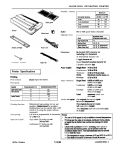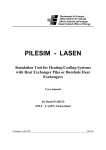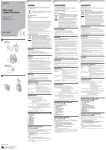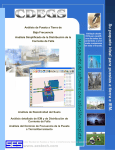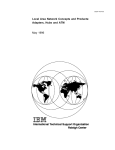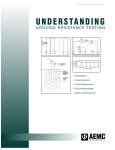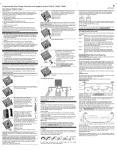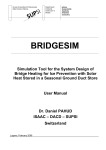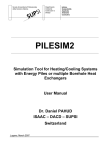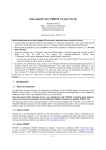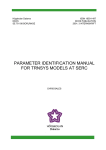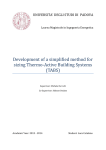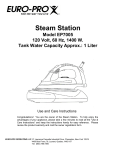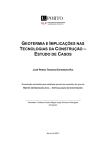Download "user manual"
Transcript
TITLE The Superposition Borehole Model for TRNSYS 16 or 17 (TRNSBM) SUBTITLE User manual for the April 2012 version Internal Report AUTHOR Dr. Daniel Pahud PLACE AND DATE Lugano, April 2012 ML_rapporto-geo v2 1/16 Table of Contents: 1. Introduction p. 3 2. The Stand Alone Model p. 3 3. The TRNSYS Version of SBM p. 4 3.1 The Input Parameter File p. 5 Data for the local problem in the borehole p. 7 Data for the hydraulic coupling between the boreholes p. 9 Data file for the borehole thermal resistances p. 10 Cell structure in the radial direction p. 13 Special format for time values p. 14 3.2 The Parameter Values p. 14 3.3 The Input Variables p. 15 3.4 The Output Variables p. 15 3.5 Information Flow Diagram p. 16 References p. 16 TRNSBM user manual for TRNSYS 16 or 17 ML_rapporto-geo v2 2/16 1. Introduction: One method of extracting heat from the ground to support a heat pump for domestic heating is to use a deep borehole. Multiple borehole systems can be used to support large heat pumps. In this case it is often necessary to re-inject heat to the ground, normally during the summer. In systems with both air conditioning and heating, heat is injected to the ground in the cooling mode and extracted in the heating mode. The proper design and dimensioning of these systems require a precise knowledge of the relation between fluid temperature and heat extraction under various conditions. The Superposition Borehole Model (SBM) has been developed by Dr. P. Eskilson at the Lund Institute of Technology (LTH), Sweden, in order to provide a tool for the analysis and design of such systems (Eskilson 1986, 1987). It has been adapted for TRNSYS in 1996 by Dr. D. Pahud (Pahud and al., 1996) at the Swiss Federal Institute of Technology (EPFL) in Lausanne. TRNSYS is a widely used, modular and flexible programme, for the simulation of transient thermal processes of a thermal energy system. With the SBM module for TRNSYS, a borehole system can be simulated, analysed and optimised as part of a complete thermal energy system. In particular, the thermal interaction between the heat pump and the borehole system is taken into account. The concept of effective borehole thermal resistance, as described by Hellström (1991), has been implemented in TRNSBM as well. The two thermal resistances that determine the borehole heat transfer characteristics may either be fixed to constant values or read in a file to reflect a flowand temperature-dependence behaviour. This former version of TRNSBM has been adapted to TRNSYS 16 or 17. It is not the multiground layers version, which is a further development of the component that has been performed by TRANSSOLAR. TRNSBM is a non standard TRNSYS Type and its Type number is set to 281. It is adapted as a genuine TRNSYS Type and complies to the TRNSYS 16 standard. All the calculations inside the component are now performed in double precision real variables. It can be compiled as a drop-in dll, which means that the TRNSYS Kernel does not need to be recompiled when TRNSBM is used. Neither the authors, nor any employees of the above mentioned institutions, makes any warranty, expressed or implied, or assumes any liability or responsibility for the accuracy, completeness or usefulness of any information, apparatus, product or process disclosed, or represents that its use would not infringe privately owned rights. 2. The Stand Alone Model: The model calculates the three-dimensional temperature field in the ground for a system with an arbitrary number of vertical or graded boreholes. The heat flow problem, assumed to occur by pure heat conduction in the ground, is solved by using the explicit forward differences (FDM). The steep temperature gradients close to the boreholes and the complicated three-dimensional geometry in the ground would require a very fine mesh with many cells. A calculation using a standard numerical method is therefore extremely cumbersome. Instead, the inherent symmetries of the process are used. This is done by the superposition technique. TRNSBM user manual for TRNSYS 16 or 17 ML_rapporto-geo v2 3/16 In each borehole, the upward and downward fluid temperatures vary along the channels and with time. The convective heat flow in the fluid channels is balanced against the conductive heat flows between the fluid channels and the borehole wall. The conductive heat transfer along the fluid channels is very small and therefore neglected. The heat balance equations in the boreholes are solved for the steady-state case. The input variations of the fluid temperature and pumping rate should therefore be on a time-scale larger than the following two limits: - 5 rb2/a time-scale over which the steady-state description with a thermal resistance circuit is valid; time-scale for the fluid to circulate through the borehole. - πnrp2⋅2H/Vf With rb : a: πnrp2 : n: rp : H: Vf : radius of the borehole [m]; thermal diffusivity [m2/s]; cross section for the flow rate [m2]; number of pipes connected in parallel in a borehole [-]; radius of one pipe [m]; borehole vertical extension [m]; flow rate through the borehole [m3/s]. For a typical borehole installation, the first limit is greater than the second one and amounts to about 2-3 hours. The time for the fluid to circulate through the borehole takes usually some minutes. Input parameters for the model are the thermal properties of the ground, assumed to be homogeneous, the borehole(s) geometry, and data for the heat collector in the borehole. The hydraulic coupling between the fluid channels of the different boreholes can be arranged in many ways. There is a choice between coupling in series, in parallel, or a hybrid of these two. Another possibility of the simulation model is that the boreholes can be coupled in separate hydraulic systems (up to five), each with independent loading conditions, i. e., independent inlet fluid temperatures or average heat extraction rates. See Eskilson (1986) for the description of the input parameters and loading conditions. Output data from the model is the heat extraction rate, the injected and extracted energy, the extracted energy of each separate borehole, the overall average value of the varying temperature along the borehole walls, and finally the inlet, outlet, and bottom temperatures of each borehole. Temperature fields may be obtained in horizontal and vertical planes. 3. The TRNSYS Version of SBM: The same flexibility as the stand alone programme is maintained in the TRNSYS version, except for the loading conditions which are reduced to the inlet fluid temperature and mass flow rate of each specified hydraulic system. (It is not possible to specify average heat extraction rates as input). Nevertheless, the air temperature on ground surface is also an input and may vary with time. The outputs returned to TRNSYS are the mean outlet fluid temperature, the mass flow rate and mean heat extraction rate per hydraulic system during the TRNSYS simulation time-step. The TRNSBM user manual for TRNSYS 16 or 17 ML_rapporto-geo v2 4/16 outputs from the stand alone programme are also written to an output file. The short-time effects due to the rapid variation of the loading conditions, not simulated by SBM, can successfully be taken into account with a “pipe” component in TRNSYS. 3.1 The Input Parameter File: TRNSBM requires 3 parameters in the TRNSYS deck (see section 3.2). All other input parameters are read in an input file. This file is the same as the one read by the stand alone SBM programme, except that the data for the loading conditions are not used. Refer to Eskilson (1986) for a detailed description of the input parameter file. A short description is given here (two values on the same card are separated with a coma or space characters): PARAMETER FILE DESCRIPTION 1. AHEAD - Name of the run. AHEAD can be any text string; (maximum 72 characters, read in FORMAT(A72)). 2. LPRT - LPRT=2, summary of input data printed. LPRT=1, input data printed (includes LPRT=2). LPRT=0, no input is printed. 3. DTOKAY - Not used. With the TRNSYS version of SBM, DTOKAY is set to the TRNSYS simulation time-step. 4. R(I) - Cell structure in radial direction. See example below. 5. RLAM, CIN - Thermal conductivity RLAM [W/mK] and volumetric heat capacity CIN [J/m3K] of the ground. 6. FREST - If FREST is equal to 0, then continue on card 7. If FREST is equal to a filename then the start temperature field in the ground will be fetched from this file, and next card is number 9. 7. TZ0 - The constant ground surface temperature [°C] (not used) 8. AT0, AT1 - The undisturbed temperature in the ground. T(z)=AT0+AT1⋅z 9. FSAVE - If FSAVE is equal to 0, nothing is stored. If FSAVE is equal to a filename then the temperature field will be stored on this file at the end of the simulation. 10. NSYM - Number of borehole symmetry groups. All boreholes in one symmetry group “sees” exactly the same surrounding. 11. NN(IS) - Number of boreholes in each symmetry group, for IS=1 to NSYM. One number for each group. TRNSBM user manual for TRNSYS 16 or 17 ML_rapporto-geo v2 5/16 12a. HWELL(IS), DISO(IS), THETW(IS) Active borehole length H [m], depth D [m] of insulated borehole and angle θ [°] from the vertical direction to the borehole axis (0° ≤ θ ≤ 90°); θ = 0° for a vertical borehole. The total borehole length is D+H. 12b. XA(IS,IP), YA(IS,IP), PSIW(IS,IP) The positions of the boreholes: X-coordinate [m] and Y-coordinate [m] at the ground surface. φ [°] is the angle between the vertical plane containing the X-axis and the vertical plane containing the borehole. φ is measured anti-clockwise from the positive X-axis direction and the projection of the borehole in the horizontal plane at Z = 0 (0° ≤ φ ≤ 360°); for a borehole in the plane formed by the X and Z-axis, φ = 0° if the borehole points towards positive X-values and 180° if it points towards negative ones; φ = 0° for a vertical borehole. IS = symmetry group. IP = borehole index. One card for each borehole in the symmetry group, i. e. NN(IS) times. - The cards 12a and 12b are repeated for each symmetry group, i. e. for IS = 1 to NSYM. 13. NZMESH - Automatic mesh generation in the vertical direction (Z-axis). NZMESH can take values from 1 to 6. Commonly used values are 5 or 6. 14. NCUT - Number of vertical cuts for the printing of vertical temperature fields in the ground. If NCUT is zero then go to 16. 15a. XV1(I), YV1(I), XV2(I), YV2(I), NVH(I) The start (X1, Y1) and end coordinates (X2, Y2) for the vertical temperature field. NVH(I) is the number of divisions in the horizontal direction. 15b. ZV1(I), ZV2(I), NVZ(I) Start (Z1) and end coordinates (Z2) in the vertical direction. NVZ(I) is the number of divisions in the vertical direction. - The cards 15a and 15b are repeated for each cut, i. e. for I = 1 to NCUT. - Number of horizontal cuts for the printing of horizontal temperature fields in the ground. If NHCUT is zero then go to 18. 16. NHCUT 17. XH1(I), YH1(I), XH2(I), YH2(I) The start (X1, Y1) and end coordinates (X2, Y2) for a horizontal vector which is part of the limit for the horizontal cut. NHX (I), NHY(I) - Number of parts that the horizontal cut shall be divided into. TRNSBM user manual for TRNSYS 16 or 17 ML_rapporto-geo v2 6/16 YLENGTH(I) - The length of a line perpendicular to the vector specified above. The two vectors specify a rectangle. ZHORIZ(I) - The depth for the horizontal cut. - The card 17 is repeated for each cut, i. e. for I = 1 to NHCUT. Each card contains all height parameters. - LQSU1=1, output information for each borehole; LQSU1=0, no output information for the boreholes. 18. LQSU1 19. STRTTM, ENDTM 20. PRETIM(I), PRNTDT(I) First print-time and printing interval for the printouts a and b. See below for other time units than seconds. Two cards 20 are required: one for the a printouts and one for the b. Start-time and end-time of the simulation. See below for other time units than seconds. With the TRNSYS version of SBM, ENDTM is increased if necessary to match the stop time of the TRNSYS simulation. a. - *Energy* Energies, inlet and outlet fluid temperatures, heat flows and temperatures at the borehole wall. b. - *Cuts* cuts. Temperature fields written in horizontal and/or vertical 21. NH - Number of time interval windows for which printing of output is wanted. 22. TIMIN(I), TIMAX(I) The limits of the time intervals for which printing is wanted. See below for other time units than seconds. The card 22 is repeated for each time interval window, i. e. for I = 1 to NH. Data for the local problem in the borehole: 23. ITYPE - Type of collector: ITYPE=0: not allowed in the TRNSYS version. ITYPE=1: collector with a concentric inner tube; ITYPE=2: U-pipe. A U-shape loop of plastic tube in the borehole; ITYPE=3: U-pipe with three plastic tubes. The flow direction is the same in two of the channels. TRNSBM user manual for TRNSYS 16 or 17 ML_rapporto-geo v2 7/16 ITYPE=4: the borehole thermal resistances Rb and the internal thermal resistance Ra are given by the user and kept constant during the simulation (Rb and Ra are given in the card 27). ITYPE=5: the borehole thermal resistances Rb and the internal thermal resistance Ra are read in a file and interpolated (Rb and Ra are flow- and temperature-dependent). Look below in section “Data file for the borehole thermal resistances” for the structure of the file. The file logical unit is given in the card 27. An assign statement has to be added in the TRNSYS deck to link the file to the logical unit. 24. IDIREC - IDIREC=1: downward in channel 1 (core). IDIREC=-1: downward in channel 2 (annulus). If CIRCUL ≤ 0, the pump-flow is reversed. See the input variables for the definition of CIRCUL. 25. VISC, DENS, CF, CONDF Fluid properties: dynamic viscosity [kg/m.s], density [kg/m3], volumetric heat capacity [J/m3K] and thermal conductivity [W/mK]. 26. If ITYPE < 4 then card 26 is: REYLI1, REYLI2 Turbulent flow limits on the Reynold numbers for channel 1 (core) and channel 2 (annulus). These number determinate the Reynold number for which the flow changes from the laminar to the turbulent regime. REYLI1 and REYLI2 are normally in the interval 2’300 to 10’000. If ITYPE = 4 or 5 then card 26 is: IGHE IGHE defines whether the borehole installation is a coaxial one or a U-pipe one. IGHE = 0: coaxial installation; IGHE = 1: U-pipe installation (n U-pipes are symmetrically installed in the vicinity of the outer boundary of the borehole). 27. If ITYPE < 4 then card 27 is: RPI, RPY, RLAMPL Inner- and outer radius of the plastic tubes [m]; thermal conductivity of the plastic tube [W/mK]. If ITYPE = 4 then card 27 is: RbGHE, RaGHE Values for respectively the borehole thermal resistance Rb and the internal thermal resistance of the borehole Ra [K/(W/m)], according to Hellström, 1991. If ITYPE = 5 then card 27 is: LUGHE Logical unit through which the data will be read (Rb, Ra, etc.). An assign statement has to be added in the TRNSYS deck to link the data file to this logical unit. TRNSBM user manual for TRNSYS 16 or 17 ML_rapporto-geo v2 8/16 28. COND1, B1, B2, B12, B13 COND1 is the thermal conductivity of the filling material (bentonite, quartz sand, water, etc.) [W/mK]. ITYPE=1: the card 28 is not read and must be omitted; ITYPE=2: B1: distance from the borehole centre to pipe 1 centre [m]. B2: distance from the borehole centre to pipe 2 centre [m]. B12: distance from pipe 1 centre to pipe 2 centre [m]. B13: not read. ITYPE=3: B1: distance from the borehole centre to pipe 1 centre [m]. B2: distance from the borehole centre to pipe 2 centre [m]. B12: distance from pipe 1 centre to pipe 2 centre [m]. B13: distance from pipe 1 centre to pipe 3 centre [m]. Pipe 1 and 3 are assumed to be symmetrically placed relative to pipe 2. Hence, the distance B3, from the borehole centre to pipe 3 centre, is equal to B1. ITYPE=4: the card 28 is not read and must be omitted; ITYPE=5: the card 28 is not read and must be omitted; Data for the hydraulic coupling between the boreholes: 29. NHYD - NHYD=0: the hydraulic coupling is generated automatically. There is one hydraulic group with all the boreholes coupled in parallel. The next cards are not used; end of the input parameter file. NHYD≥1: NHYD is the number of hydraulic system, i.e. the number of systems that will be independently operated. The maximum number of hydraulic systems is limited to 5. 30. NHYD1(I1) - Number of groups within the hydraulic system I1, for I1=1 to NHYD. One number for each hydraulic system. A group is formed by several channels coupled in parallel. A channel is defined by several symmetry groups coupled in series. Within a symmetry group, all the boreholes are connected in parallel, as they “see” exactly the same surrounding and behave exactly in the same manner. A group has a common inlet fluid temperature. The outlet flow from the channels of a group are mixed and used as inlet flow to the next group. The mixed outlet temperature from the channels of the last group is the outlet temperature from the hydraulic system. TRNSBM user manual for TRNSYS 16 or 17 ML_rapporto-geo v2 9/16 31. NHYD2(I2) - Number of channels in the group I2, for I2=1 to ΣNHYD1(I1). One number for each group, from hydraulic system 1 to hydraulic system NHYD. 32. NHYD3(I3) - Number of symmetry groups in channel I3, for I3=1 to ΣNHYD2(I2). One number for each channel, from group 1 of the first hydraulic system to the last group (group number ΣNHYD1(I1)) of the hydraulic system NHYD. 33. ZFLUID(I3) - The part of the total fluid flow QWDEM(I1) that passes through channel I3. I1 is the hydraulic system number associated with the channel I3. I3=1, … ΣNHYD2(I2). One number for each channel, from group 1 of the first hydraulic system to the last group (group number ΣNHYD1(I1)) of the hydraulic system NHYD. 34. NHYD4(I4) - The specific index for the symmetry group I4, I4=1, … ΣNHYD3(I3). Data file for the borehole thermal resistances The borehole thermal resistance (Rb) and the internal one (Ra) have to be calculated for 5 fluid temperatures and 10 flow rates. The temperature and flow rate values are chosen so that the whole range of possible values is covered. Last but not least, the resistance values have to reflect the flow regime transition at Reynold number 2’300. Five values of flow rate are thus fully determined, as the Reynold number has to be calculated to 2’300 for each of the five temperature values. These five flow rates are inserted in the middle of the flow rate range. For each temperature and flow rate value, the Reynold number is calculated together with the thermal resistances, determined both for laminar and turbulent flow regime. A non commercial programme, called BOR (Pahud, 1997), was created to automatically generate the Rb, Ra and Reynold values calculated with the EED programme (Hellström and all., 2000). The data file has to follow the specific structure given below. Several values in a line of the file have to be separated with space characters. First line: Second line: Third line: Fourth line: Lines 5 to 14: - five values of the heat carrier fluid temperature [°C], given in increasing order; - first five values of the fluid flow rate per borehole [m3/s], given in increasing order; - last five values of the fluid flow rate per borehole [m3/s], given in increasing order; empty - first block of data calculated for the first fluid temperature given in the first line. - each lines contains 5 values: Rb_turbulent [K/(W/m)], Ra_turbulent [K/(W/m)], Rb_laminar [K/(W/m)], Ra_laminar [K/(W/m)] and Reynold number [-] - the 10 lines are calculated for each value of the flow rate, in the order given in lines 2 and 3 Line 15: empty New block of data, repeated 4 times for the last 4 fluid temperatures. An empty line separates each block. TRNSBM user manual for TRNSYS 16 or 17 ML_rapporto-geo v2 10/16 The following example is a data file created with the BOR programme for a double U-pipe borehole heat exchanger. It should be noticed that the text file following the numeric values is ignored when the file is read by TRNSBM. It is used to record conditions and parameters at which the calculations were made. -15.0 -10.0 -5.0 5.0 15.0 0.00003857 0.00035100 0.00038572 0.00059669 0.00098441 0.00128067 0.00170952 0.00239333 0.00376094 0.00854760 0.0528 0.0528 0.0528 0.0528 0.0528 0.0528 0.0522 0.0514 0.0505 0.0495 0.2051 0.2051 0.2051 0.2051 0.2051 0.2051 0.2031 0.2000 0.1969 0.1934 0.1018 0.1018 0.1018 0.1018 0.1018 0.1018 0.1018 0.1018 0.1018 0.1018 0.3835 0.3835 0.3835 0.3835 0.3835 0.3835 0.3835 0.3835 0.3835 0.3835 52. 472. 519. 803. 1324. 1723. 2300. 3220. 5060. 11500. 0.0532 0.0532 0.0532 0.0532 0.0532 0.0526 0.0518 0.0510 0.0502 0.0494 0.2065 0.2065 0.2065 0.2065 0.2065 0.2044 0.2014 0.1987 0.1960 0.1930 0.1018 0.1018 0.1018 0.1018 0.1018 0.1018 0.1018 0.1018 0.1018 0.1018 0.3835 0.3835 0.3835 0.3835 0.3835 0.3835 0.3835 0.3835 0.3835 0.3835 69. 630. 693. 1072. 1768. 2300. 3070. 4298. 6754. 15351. 0.0541 0.0541 0.0541 0.0541 0.0530 0.0521 0.0514 0.0507 0.0500 0.0493 0.2097 0.2097 0.2097 0.2097 0.2058 0.2027 0.2001 0.1976 0.1952 0.1926 0.1018 0.1018 0.1018 0.1018 0.1018 0.1018 0.1018 0.1018 0.1018 0.1018 0.3835 0.3835 0.3835 0.3835 0.3835 0.3835 0.3835 0.3835 0.3835 0.3835 90. 820. 901. 1394. 2300. 2992. 3994. 5592. 8787. 19971. 0.0547 0.0547 0.0547 0.0537 0.0520 0.2117 0.2117 0.2117 0.2083 0.2022 0.1007 0.1007 0.1007 0.1007 0.1007 0.3793 0.3793 0.3793 0.3793 0.3793 149. 1353. 1487. 2300. 3794. TRNSBM user manual for TRNSYS 16 or 17 ML_rapporto-geo v2 11/16 0.0513 0.0507 0.0502 0.0497 0.0491 0.1999 0.1978 0.1959 0.1940 0.1919 0.1007 0.1007 0.1007 0.1007 0.1007 0.3793 0.3793 0.3793 0.3793 0.3793 4936. 6590. 9225. 14497. 32948. 0.0548 0.0548 0.0545 0.0528 0.0514 0.0508 0.0503 0.0499 0.0495 0.0490 0.2122 0.2122 0.2112 0.2049 0.1999 0.1980 0.1963 0.1948 0.1932 0.1915 0.1007 0.1007 0.1007 0.1007 0.1007 0.1007 0.1007 0.1007 0.1007 0.1007 0.3793 0.3793 0.3793 0.3793 0.3793 0.3793 0.3793 0.3793 0.3793 0.3793 230. 2093. 2300. 3558. 5870. 7637. 10194. 14271. 22426. 50969. BOR version 970217 Date: 1997-2-19 Time: 21.53 by Daniel Pahud, based on the Earth Energy Designer Input file: D:\BOR\2U_PIPE3.DAT This output file: D:\BOR\2U_PIPE3.BOR MEMORY NOTES FOR PROJECT 1: Double U_pipe installation (PE DN32mm, PN10) 2: (!! the PE can't stand high temperatures !!) 3: Filling material: quartz sand 4: Spacers to keep apart the pipes 5: D E S I G N D A T A ====================== GROUND Ground Thermal Conductivity 2.500 W/m,K BOREHOLE Borehole installation DOUBLE-U Borehole diameter 0.100 m WARNING: the U_pipe(s) is (are) supposed to be symmetrically placed in the borehole. A deviation to the symmetrical case tends to increase the borehole thermal resistance. U-pipe diameter 0.032 m U-pipe thickness 0.0030 m U-pipe thermal conductivity 0.420 W/m,K U-pipe shank spacing 0.0600 W/m,K Filling Thermal Conduct. (unfrozen) 2.000 W/m,K Filling Thermal Conduct. (frozen) 2.000 W/m,K TRNSBM user manual for TRNSYS 16 or 17 ML_rapporto-geo v2 12/16 Contact Resistance Pipe/Filling Number of multipoles 0.0100 K/(W/m) 5 HEAT CARRIER FLUID Fluid type USER DEFINED Fluid properties at temperature Thermal Conductivity Heat Capacity Density Viscosity -15.0 0.440 3790 1044 0.019000 øC W/m,K J/kg,K kg/m3 kg/m,s Fluid properties at temperature Thermal Conductivity Heat Capacity Density Viscosity -10.0 0.440 3800 1043 0.014220 øC W/m,K J/kg,K kg/m3 kg/m,s Fluid properties at temperature Thermal Conductivity Heat Capacity Density Viscosity -5.0 0.440 3810 1042 0.010920 øC W/m,K J/kg,K kg/m3 kg/m,s Fluid properties at temperature Thermal Conductivity Heat Capacity Density Viscosity 5.0 0.450 3830 1039 0.006600 øC W/m,K J/kg,K kg/m3 kg/m,s Fluid properties at temperature Thermal Conductivity Heat Capacity Density Viscosity 15.0 0.450 3850 1035 0.004250 øC W/m,K J/kg,K kg/m3 kg/m,s ******** END OF FILE ********** Cell structure in the radial direction: The cell structure covers the radial region comprised between an inner boundary, defined by the radius of the borehole, and an outer boundary, set sufficiently far away, so that the radial thermal flux at this outer boundary is always negligible during the simulation period. Three cards are used to define the mesh. The first card contain the radius value of the boreholes ro [m]. The integer value on the second card indicates the number of “pairs” that the third card contains. The mesh TRNSBM user manual for TRNSYS 16 or 17 ML_rapporto-geo v2 13/16 structure is defined with the radial extensions of each cell, i. e., the difference between its outer and inner radius, given in order from the inner boundary. The first value of a pair indicate how many times a mesh is repeated, and the second value specifies the radial extension of that cell. For example, the following 3 cards define the mesh structure given below: Card 1: ro, the borehole radius [m]. 0.05 Card 2: number of pairs on card 3. 11 Card 3: for each pair: number of mesh [-], radial extension of the mesh [m]. 3 0.1 1 0.2 1 0.4 1 0.8 1 1.6 1 3.2 1 6.4 1 12.8 1 25.6 1 51.2 2 100. The defined mesh is [m]: r = 0.05 0.15 0.25 0.35 0.55 0.95 1.75 3.35 6.55 12.95 25.75 51.35 102.55 202.55 302.55 Special format for time values: An easy way can be used to specify the time. A sequence of pairs formed by a number and one of the following letters is given: Y Q D H M S Year (365 days, 31’536’000 seconds). Year/12 (39.417 days, 2’628’000 seconds). Day (86’400 seconds). Hour (3’600 seconds). Minutes (60 seconds). Seconds. Examples: 1Y12D 25D4H2M 3Q500S 1 year and 12 days 25 days 4 hours and 2 minutes 3/12 year and 500 seconds. 3.2 The Parameter Values: PARAMETER VALUES DESCRIPTION 1. NHYD - Number of hydraulic circuit. This parameter ranges from 1 to 5 and has to be equal to the number of hydraulic circuits defined in the input parameter file for TRNSBM. 2. LUINSBM - Logical unit for the input parameter file for TRNSBM. An assign statement has to be written in the TRNSYS deck to link the input parameter file name to this logical unit. TRNSBM user manual for TRNSYS 16 or 17 ML_rapporto-geo v2 14/16 3. LUOUTSBM - Logical unit for the output file created by TRNSBM. An assign statement has to be written in the TRNSYS deck to link the output file name to this logical unit. 3.3 The Input Variables: INPUT VARIABLES DESCRIPTION 1. Tair - Air temperature on ground surface [°C] For i = 1 to NHYD hydraulic systems (NHYD=MAX(1,NHYD) and NHYD ≤ 5): (3·i - 1). Tin(i) - Inlet fluid temperature in hydraulic system i [°C] (3·i). min(i) - Total mass flow rate in hydraulic system i [kg/h] (3·i + 1). Circul(i) - Switch to set the circulation of the fluid through the hydraulic system i [-] If Circul(i) > 0: the fluid circulates from symmetry group to symmetry group and from group to group according to the manner they where ordered in the hydraulic system i. In a borehole, the fluid circulates as indicated in card 24 of the input parameter file. If Circul(i) ≤ 0: the fluid circulation is reversed in hydraulic system i. 3.4 The Output Variables: OUTPUT VARIABLES DESCRIPTION For i = 1 to NHYD hydraulic systems (NHYD=MAX(1,NHYD) and NHYD ≤ 5): (3·i - 2). Tout(i) - Average outlet fluid temperature in hydraulic system i. If there is no flow, the outlet temperature is set to the average temperature on the borehole wall [°C] (3·i - 1). mout(i) - Total mass flow rate in hydraulic system i [kg/h] (3·i). Q(i) - Average exchanged heat rate in hydraulic system i [kJ/h] TRNSBM user manual for TRNSYS 16 or 17 ML_rapporto-geo v2 15/16 3.5 Information Flow Diagram: INPUTS: OUTPUTS: PARAMETERS: 4 to 16 or (1 + 3·i) i: number of hydraulic systems (1 to 5) 3 to 15 or (3·i) 3 (the SBM parameters are read in an input parameter file through logical unit given by the second parameter). Hydraulic system 1 INPUTS: Tair T in(1) 1 2 m in (1) 3 Circul(1) 4 5 ... TYPE 281 TRNSBM Superposition Borehole Model for TRNSYS 1 OUTPUTS: T (1) out 2 m out (1) 3 4 ... Q(1) Hydraulic system 1 References: Eskilson P. (1986) Superposition Borehole Model. Manual for Computer Code. Department of Mathematical Physics, Lund Institute of Technology, Lund, Sweden. Eskilson P. (1987) Thermal Analysis of Heat Extraction Boreholes. Department of Mathematical Physics, Lund Institute of Technology, Lund, Sweden. Hellström G. (1991) Ground Heat Storage. Thermal Analyses of Duct Storage Systems. Theory. Thesis, Department of Mathematical Physics, University of Lund, Sweden. Hellström G., Sanner B. (2000): Earth Energy Designer, User’s Manual, version 2.0 (http://www.buildingphysics.com/). Pahud D., Fromentin A. and Hadorn J.-C. (1996) The Superposition Borehole Model for TRNSYS (TRNSBM). User Manual for the November 1996 Version. Internal Report. LASEN - DGCEPFL, Switzerland. TRNSBM user manual for TRNSYS 16 or 17 ML_rapporto-geo v2 16/16
















